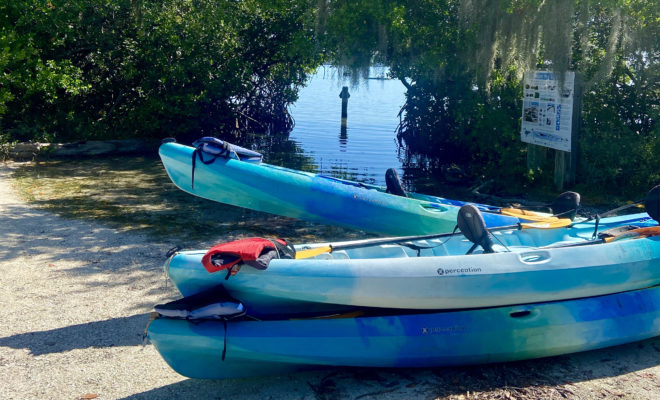
Feature
Ahoy Sarasota! Let’s Have Fun on the Water
By Sylvia Whitman
November 2020 – We’re gathering at Ted Sperling Park on Lido Key this sunny Tuesday morning to leave the pandemic behind.
The parking lot is filling with outfitters pulling trailers striped with colorful kayaks. I find Tyler of Kayaking SRQ Tours and Rentals, who checks me in, offers a bottle of water and a waterproof pouch for my phone, and points me toward the bathrooms and a short shell trail. There, a sign educates me about the “lively beach wrack community”: Various grasses and algae support a food chain most visible to humans in shorebirds like terns, skimmers, and red knots.
I have no inclination to check my email.
Orientation, by the picnic tables, takes all of two minutes. I’ve kayaked just a couple of times before, but the vessel is almost idiotproof. We’re a small tour—I and three members of a Sarasota newcomers group scoping out possible future activities, a fellow solo paddler and a couple taking out a two-seater. As we walk steps to the launch site, a break in the vegetation where water laps sand, Tyler’s helper makes a booger joke as he removes a giant moon jellyfish that has washed ashore.
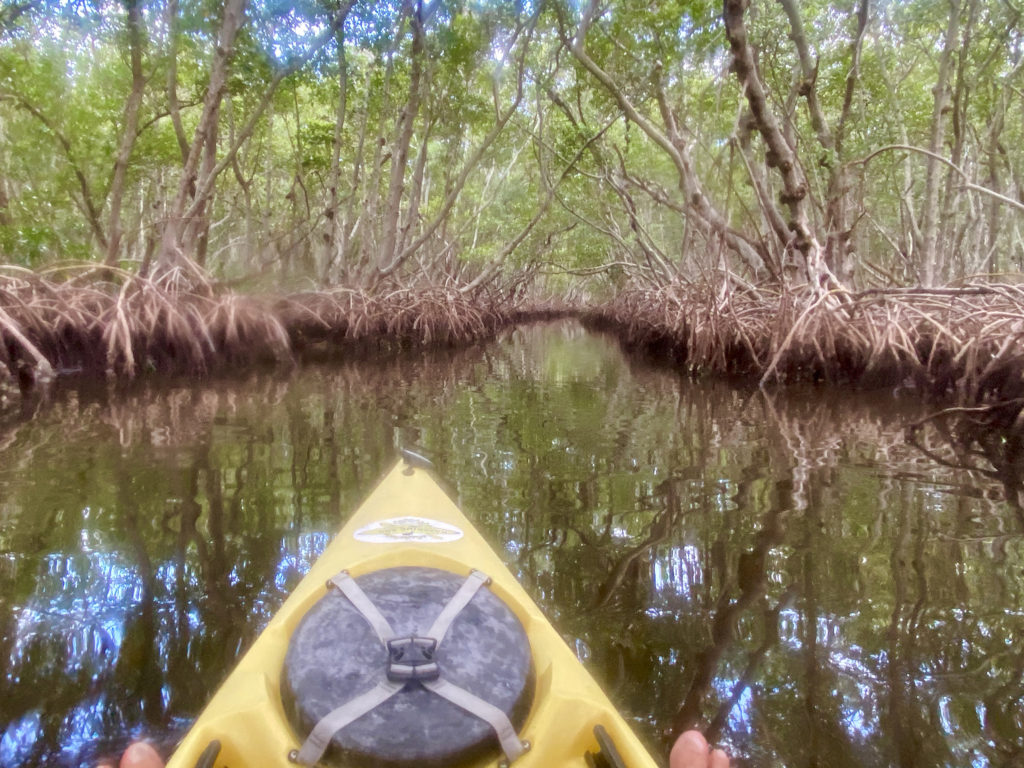
Tyler assures us that there’s no graceful way to board a kayak. Just walk into the water, plunk your butt into the seat, and swing your legs over the side. Then lean against the padded backrest and adjust the foot braces so that your knees rise into a low A-frame. Hold the Q-tip of a paddle across your lap. Powered by a shove, one by one we float into Sarasota Bay.
I stash my face mask.
Tyler joins us on a paddleboard that allows him to both sit and stand. He instructs us in effective paddling; a loose grip prevents blisters.
As we follow him across shallow grassy flats, he points out a cormorant and explains that these large birds love kayakers because our paddles flush out their chow. Within minutes, ignoring every guideline about social distancing, a gulp of emerald-eyed cormorants is swimming alongside us, diving under our kayaks and emerging with tiny fish twitching in their beaks. The birds toss them back like shiny peanuts, and I can follow their movement down the birds’ orange-striped gullets.
We’re looking for manatees, Tyler explains, as we paddle past Otter Key. Sometimes they gather along the sea walls behind Lido Key mansions, especially where springs emerge. We’re looking for bubbles—not water but manatee flatulence.
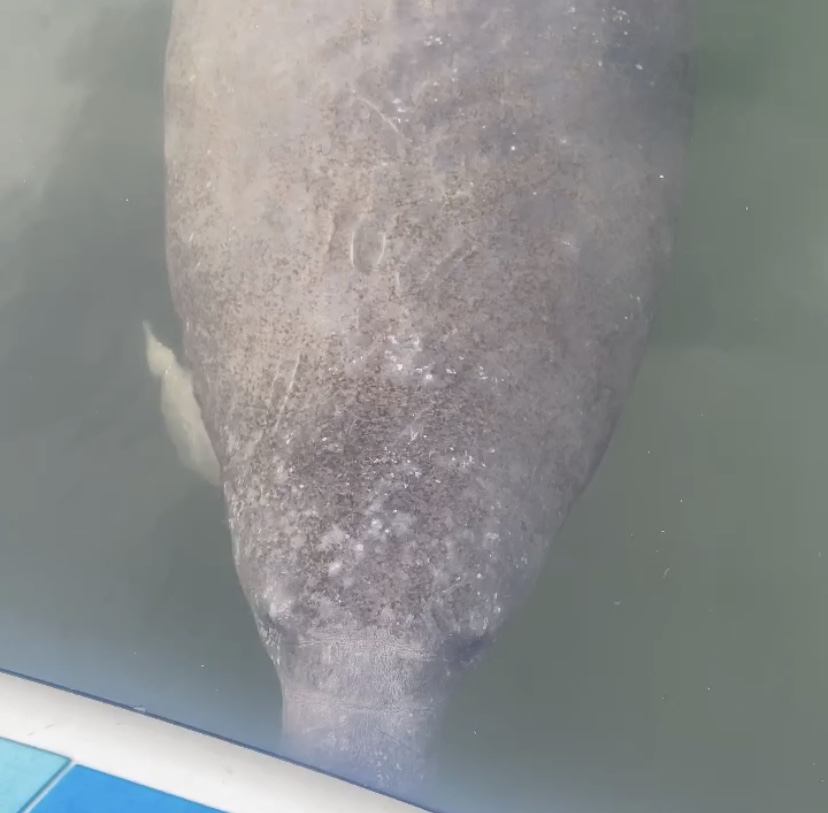
As we ogle the grand balconies and patios, Tyler sketches out local history—the misspelled deed behind St. Armand’s Circle, John Ringling’s big ambitions for the small island before the 1929 stock market crash. We pass under the Boulevard of the Presidents, coasting some, chatting quietly. It feels good to just be.
We see many hard-working gardeners on land but no gaseous manatees in the water. We head back, into the wind, pumping a bit. During months away from the gym, my legs have grown strong from walking, but my arms appreciate this workout.
Frigate birds with their 7-foot wingspans fly high above us like the V’s in a child’s drawing. Tyler points out osprey in the dying Australian pines that Ringling planted. On the rusted ruins of a dredge, a cormorant fans its feathers to dry, but we all spot the fishing filament dangling from its beak—a reminder of how, with a few careless moves, we can love our environment to death. Tyler says he and his fellow tour guides report such sightings to Save Our Seabirds, which runs a rescue and rehab hospital.
After stirring up another cormorant feast in the grassy flats, we head toward the mangrove tunnels. Pulling a floating propagule from the water, Tyler explains the lifecycle of red mangroves, watery evergreens with spidery roots that serve as fish nurseries and hurricane buffers. They’re so essential that state law imposes stiff fines for illegal trimming. The Army Corps of Engineers, however, cut tunnels through the mangrove thickets to enable seawater to flush out mosquito breeding pools, and they’ve become a natural fun ride. As we head single file into a tunnel, we bump and twist in the cool canals under the canopy. Perched on a root, a great white heron watches unruffled.
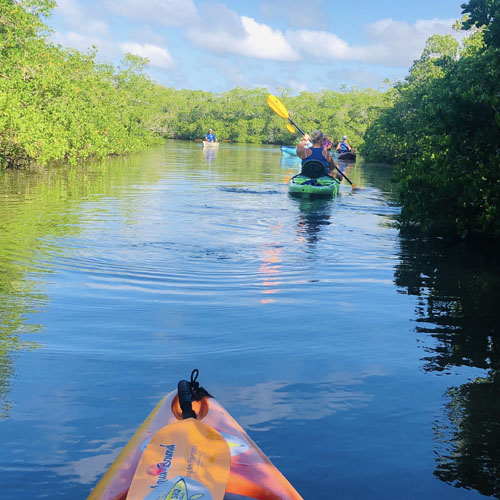
Time’s up. But the Bay delivers one more treat—a bald eagle streaking over the mangroves.
A different kind of zooming.
Tyler warns us about numb butt, and yes, there’s no graceful way to exit a kayak either. But I feel great.
Eat your heart out, denizens of cold climes. Hunker down in front of your computers. I plan to dip my paddle in the water all winter.
On the Water with Friends
Like the owl and the pussycat in Edward Lear’s poem, some Sun Coasters prefer their aquatic recreation with buddies. Whether you surf, snorkel, ski, or fish, there’s no shortage of organizations beckoning you to combat isolation safely in good company. Where to start? Check out the county parks and rec listings. Or browse Sarasota’s many, many Meetup groups.
Private clubs point to another inlet to fun on the water. Only about half of Sarasota Yacht Club’s 660 or so members own boats, according to general manager Karen Harmon, but all enjoy the Gulf in some way. They dine and drink “docktails” beside the Bay, watch regattas, rent paddleboards, and hitch rides on weekend cruises.
Youth sailing participation has “exponentially increased” during the pandemic, says Harmon. For veteran sailor and Sarasota Middle Schooler Wyatt Wrigley, 13, getting out on the water has been “kind of a relief” in these cooped-up times.
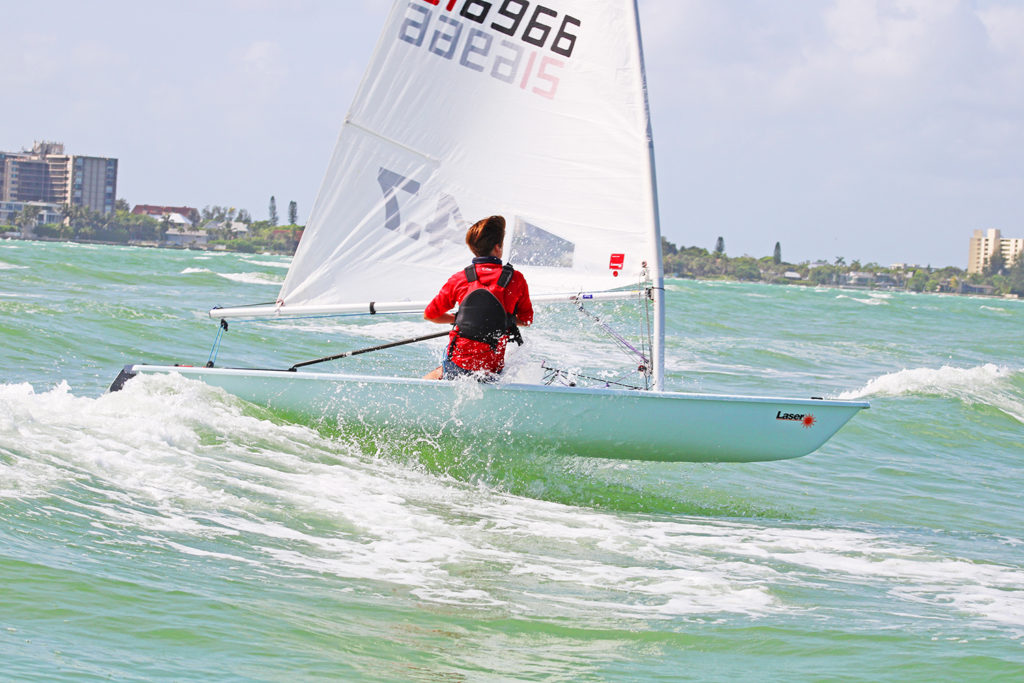
Not long after his parents joined SYC, Wyatt signed up to learn how to sail, thinking it would be “nice to meet some new friends.” In elementary school, he started out in an O’pen Bic, a simple skiff, and “eventually I went to my first sailing regatta,” he says. “I was nervous. But I liked it.” Since then he’s won a few races—and even placed first in part of a regatta series.
Through the school year Wyatt practices with the sail team, and during the summer he participates in SYC camps. Right now he’s racing an Opti, debating if he’s ready to move up to a Laser. “Sailing’s a nice skill. You can use it to your advantage,” he says. “You can go sailing around the world or get a scholarship to go to college. It can take you places.”
Less competitive but no less fun, according to newly installed SYC Commodore Brian Will, is the organized cruising program. Once a month, the schedule planned a year in advance, boats set out from SYC on a Friday for a Gulf Coast destination—often another club, since members of the Florida Council of Yacht Clubs enjoy reciprocal privileges, including one free night’s berth. Some cruisers sleep aboard ship; other check into hotels.
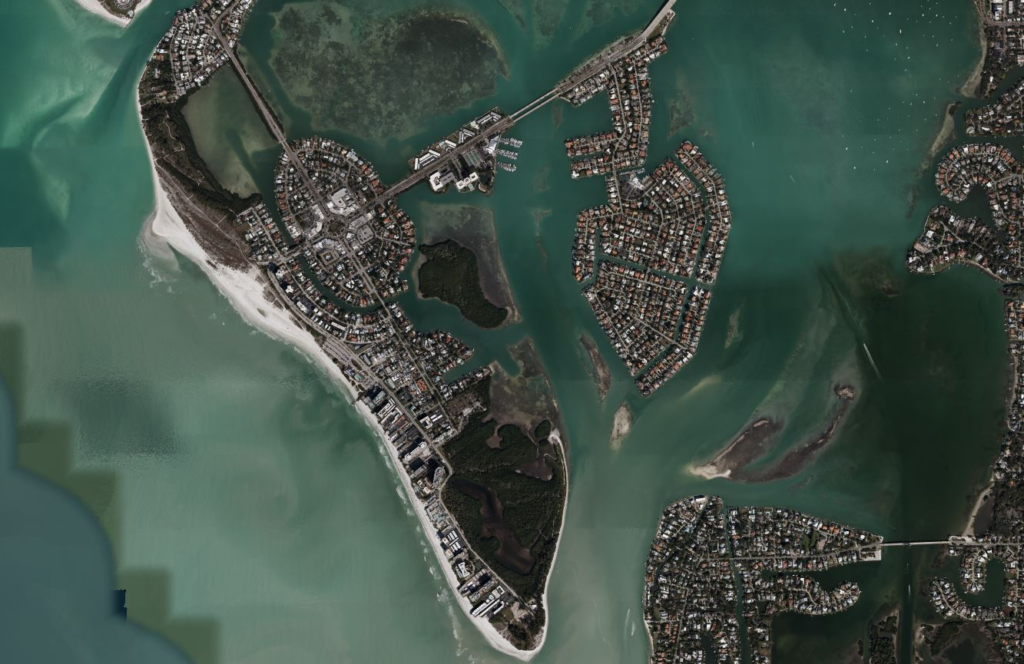
In October, for instance, a flotilla of a dozen boats embarked on a voyage to a commercial marina in Boca Grande. “It’s not really an elephant walk, nose to tail,” says Will, but captains radio each other along the way, and new members unfamiliar with the shoals of Sarasota Bay and its inlets often follow another boat’s lead. Most of the cruisers arrived within three hours, but the sailboat took six and a half. Sometimes the SYC cruisers share a potluck dinner or a progressive meal from deck to deck, but in Boca Grande the group decamped for the Pink Elephant. Saturday morning, the group set up its portable bocce court, lubricating the competition with mimosas and bloody Mary—or soda, of course—before crowning champions and heading out for lunch and golf, deep-sea fishing, or other activities. They met for dinner at the marina’s restaurant and on Sunday headed home.
Cruises are seagoing socials. “This is a very diverse group,” says Will. Folks range in age from their 30s to their 80s, boat owners and guests. “We’re really big on inclusivity.”
What unites member of SYC, according to Will, those with and without title to yachts, is their susceptibility to the lure of the sea. Will and his wife, Martha, “got bit by the boating bug” more than 25 years ago. They started with a small runabout and then traded up twice. “It’s not really a hobby,” he muses. “It becomes a kind of insanity.”
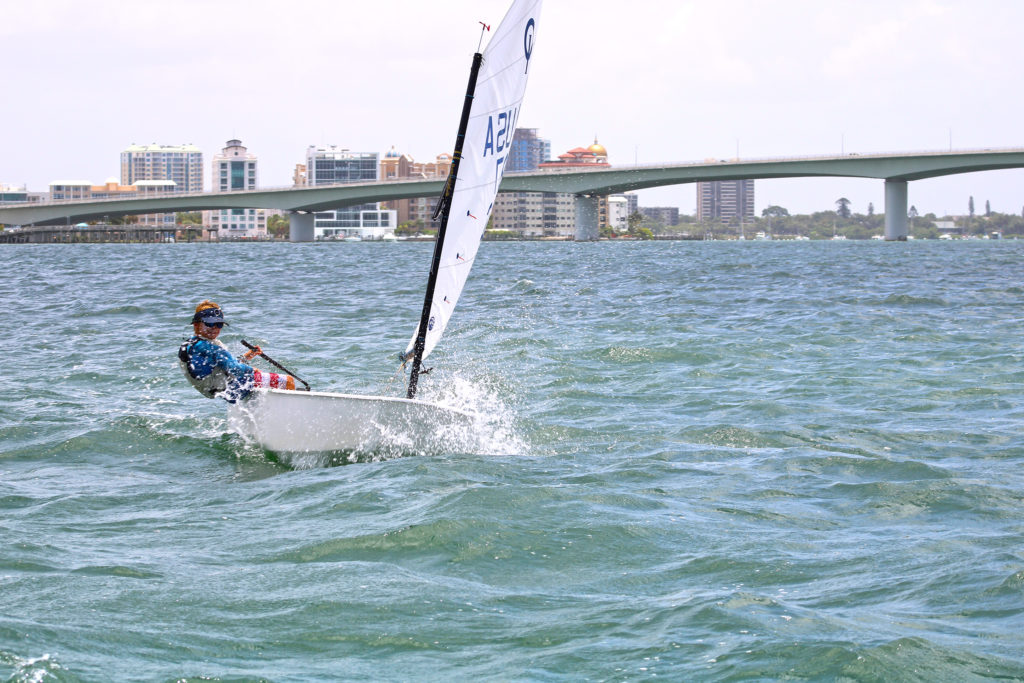
According to Will, a “hard-to-explain” feeling tugs on your heart the way a magnificent sunrise or sunset does. It starts “when you drop the lines, and you pull out from your slip. And you realize that you have an open horizon, and you don’t know what the adventures are going to be, or what the misadventures might be on that trip. But it’s just a tremendous sense of freedom, being out on the water and experiencing nature that way.”
Something about the common experience compounds the emotion. “Occasionally you look around and see your boating neighbors, either ahead of you or behind you, and … it’s a very rewarding feeling.”
Probably the best way to understand what he means is to give it a try.



You must be logged in to post a comment Login